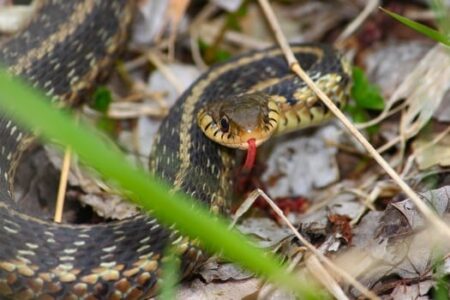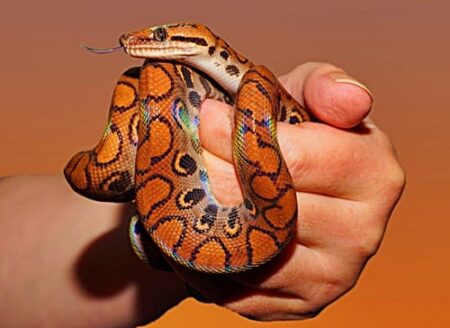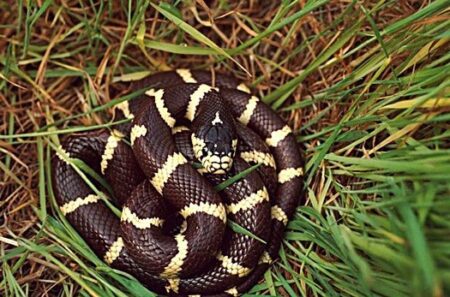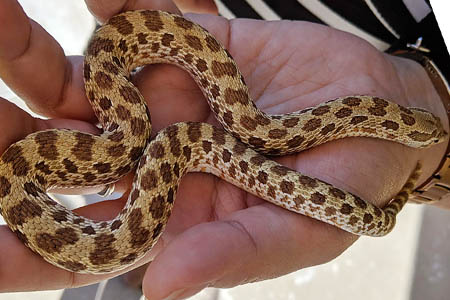A snake makes an ideal pet for some families. They do not need walks in the rain and can be left home alone for several days at a time. They are typically healthy, robust, and low-maintenance pets.
Most reptile experts agree that the Corn Snake, Garter Snake, Ball Python, California Kingsnake, and the Western Hognose Snake are the most docile and gentle-natured pets.
There is much more to know before getting a snake as a pet. Snakes need specific care and nutrition to grow and thrive. Provide this care and you will have a long and happy relationship as it’s not uncommon for some snake breeds to live for up to 30 years in captivity.
Things to Consider Before Getting a Pet Snake
Many things should be thought about before you bring a snake home. These include the following:
- Hours of Activity. Some snakes are nocturnal, while others are diurnal. If you want an active snake that you can interact with, choose one according to your work and lifestyle commitments.
- Feeding. The food that snakes live on isn’t for everybody. Snakes aren’t vegetarians. Can you cope with the idea of feeding live or frozen rats and mice to your snake?
- Escapology. Some snake breeds are excellent at escaping their terrariums. Are there other pets in the house to bear in mind?
- Personality. Every breed of snake is different. Some like to burrow, and others prefer to stay above ground. Some love to climb, while others prefer to hide.
- Habitat. You must have a terrarium ready for your snake. That means a substrate, lighting, heating, hides, and water bowl.
- Temperature. You’ll need the right amount of humidity. The better you can mimic a snake’s natural habitat, the happier they will be. Snakes also need humidity to assist with the shedding process.
- Maintenance. Your snake’s terrarium will need to be thoroughly cleaned from time to time. Are you prepared to clean out snake poop and urine? If so, do you have a second habitat that your snake can live in while the cleaning is taking place?
- Ambient Lights and Noise. Snakes need light/darkness cycles of 12 hours each to be happy. They can be distressed by too much noise.
- Lifespan. Adopting a pet snake is a long-term commitment. Snakes can live as long as 30 years in a captive setting. Are you prepared to accept this level of responsibility?
Keep all of these things in mind before choosing to introduce a pet snake to your home. If you are sure that you can care for the snake appropriately, you should go ahead. Your snake will appreciate a good home. That’s why snakes live longer in captivity than in the wild.
What are the Most Friendly Snakes?
Let’s take a look at the 5 friendliest snake breeds. Any of these could make an ideal pet for a family of snake enthusiasts.
Garter Snake
Gartner snakes are docile by nature, making great pets for children. They are smaller than many snake breeds, reaching 16 to 36 inches in length. This means they can often live in a 20-gallon terrarium when fully grown.

The more you handle a garter snake, the friendlier it’ll become. They generally stay on the floor of their habitat and are easy to feed, although feeding baby garter snakes requires more practice.
Here’s our full guide to garter snake care.
Corn Snake
Corn snakes are hugely popular pet among enthusiasts. This is partly due to their striking and colorful appearance, and partly their personality.
A corn snake tends to be curious and inquisitive, making them adorable to watch in their terrarium.
Baby corn snakes may nip until they learn to calm their aggression. This will not take long, however, and you don’t need to worry. These hatchlings have tiny teeth and a non-venomous bite.

Some corn snakes grow as large as six feet, and they love to climb. You may find that a corn snake gets unusually quiet during the winter, though. Like all snakes, they’re cold-blooded and don’t enjoy cold climates.
Here’s our full guide to corn snake care.
California Kingsnake
A California kingsnake may not be ideal for first-time snake owners. If you have the experience to handle a slightly more tempestuous snake, however, they can be tamed. Expect the snake to grow to around four feet as standard, but they could reach six feet.
This snake is named because it has a voracious appetite, and even eats other snakes in the wild. This means that you will rarely need to worry about a kingsnake being off its food.

You will have to be patient when teaching a California kingsnake to be a pet. They think everything is food, and these snakes will escape their terrarium if given half a chance. This means that, if you have other pets in the home, you may wish to avoid this species.
Do not let any of this put you off the kingsnake as a pet, however. Given time, these snakes will become tame and hugely entertaining.
Here’s our full guide to California kingsnake care.
Ball Python
The ball python is the most popular pet snake in the United States. This is for a good reason: these snakes are friendly, docile, and a lot of fun.
A ball python will crawl all over the enclosure so it will provide plenty of entertainment. They are nocturnal snakes, but can and do adjust to the human time schedule.

The only other note of caution for a ball python is its dietary habits. These snakes can be fussy eaters, and sometimes go for months without feeding. This may unnerve a first-time snake owner.
Western Hognose Snake
If you are looking for a unique snake to keep as a pet, look no further. The Western hognose is a fascinating snake, exceptional in both appearance and personality.
These snakes are smaller than most breeds, with their size maxing out at around four feet, often less. They also have a snout at the tip of their head, hence the name.
They love to burrow and hide in their environment, and they are arguably the most docile breed of snake of all.

The Western hognose is also verbal. They are fearful and will attempt to scare off predators by hissing, puffing, and spreading.
If a Western hognose does attack, it will rarely open its mouth, let alone bite. A Western hognose is more likely to flee a predator, before rolling over and playing dead. This makes them very entertaining and fun.
What is the Most Docile Snake?
Any of the snake breeds that we have listed are docile and family-friendly. Perhaps the ball python and Western hognose are the most passive.
Naturally, any snake is capable of aggression. Any animal is capable of aggression if frightened or stressed. With patience and regular handling, however, you can tame any of these breeds.
What are the Cutest Pet Snakes?
This is difficult to answer, as cuteness is in the eye of the beholder. Any of the friendly breeds that we have profiled qualify as cute for different reasons.
The Hognose, for example, has big round eyes and a unique snout. Corn snakes and California kingsnakes come in a variety of beautiful colors. Ball pythons get their name from their habit of curling up in a ball, which can be adorable. Garter snakes are cute and small.
Friendly Snakes as Pets
If you have a tame snake, it’ll make a good pet. However, certain limitations come with making a snake a pet.
Remember that you cannot make a snake behave in whatever way you please. If you want a snake that you can play with, but your pet is not responsive, do not force it.
You must also treat snakes with respect. Young children may want to use a pet snake to scare their friends. Ensure they understand that a pet snake is a living creature, not a toy.
Finally, remember that we are much bigger than our pets. Humans may be afraid of snakes, but snakes are much more afraid of humans.
Do not do anything that will cause your pet snake undue stress. This also includes not making too much noise or handling a snake unexpectedly.
How to Make Snakes Friendly
When you first bring a snake home, they are going to be nervous. You will need to gain your snake’s trust gradually.
Week One
When you first bring your snake home, don’t physically interact with it at all. Set up its terrarium, and let it get to grips with its new surroundings.
Wait at least a week before attempting to touch your snake. During this time, sit outside its terrarium for at least an hour a day. This will help your snake to recognize your scent.
Week Two
After a week or so, move a few things around your snake’s terrarium while they are awake to see this. Maybe introduce some new, fun rocks or logs.
Do not touch them throughout this process. You are showing your snake that you are taking care of them and not a threat. Touching before they are ready could still frighten them.
Week Three
By now, you should have started to gain your snake’s trust. You can now start trying to touch them.
Wash your hands thoroughly. Snakes don’t have great eyesight, but they do have an excellent sense of smell. Even the weakest aroma of prey food might lead to them biting.
Start by lifting its tail, and running your fingers down its back. Move the snake around the terrarium gently. Do this for a few days before attempting to pick it up. If it seems uncomfortable, stop and try another time.
General Tips for Taming a Snake
Here are some tips for building a friendly relationship with your pet snake:
- Be patient and understanding. A snake may behave aggressively when you first try to handle it. This doesn’t mean they are not trainable. They’re just scared.
- Handle your snake regularly. If your snake only sees you at feeding time, it’ll assume everything in its terrarium is food.
- Never restrain a snake’s head. This will make it think that you have ill intent. When scared, a snake will act aggressively.
- Respect the limits of your snake’s patience. If it is visibly uncomfortable and afraid, leave your snake alone for a while. You cannot hurry the process of making a snake into a family pet.
Make sure that its terrarium is the right size, and has the ideal substrate. The more relaxed your pet snake feels, the happier it will be as a pet.
Do Pet Snakes Feel Affection?
If you need unconditional affection, you should get a dog. Likewise, if you are looking for a pet that will lie still in your lap, maybe a cat is advisable.
A snake is not genetically hardwired to feel love or affection. Like all reptiles, snakes are concerned with survival. This means that they focus almost entirely on staying warm, feeding, and hiding when necessary.
Your snake will eventually recognize your scent. Your snake may even come to enjoy the contact. Being cold-blooded, a snake may find your hands warming and pleasant against its scales.
You should always purchase your snake from a pet store or a reputable, licensed breeder. Discuss your circumstances with an expert, and agree together which breed will suit you best.

